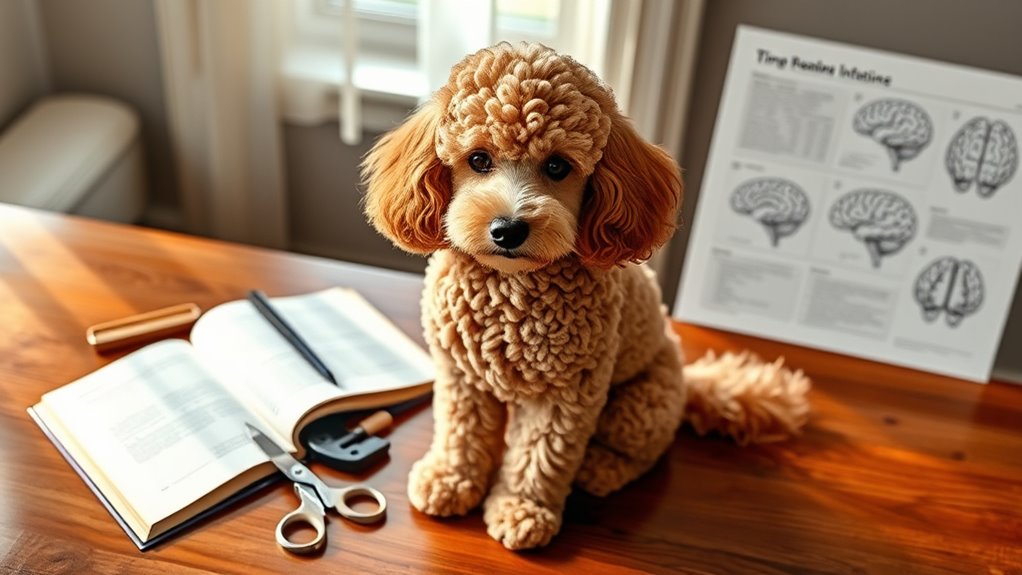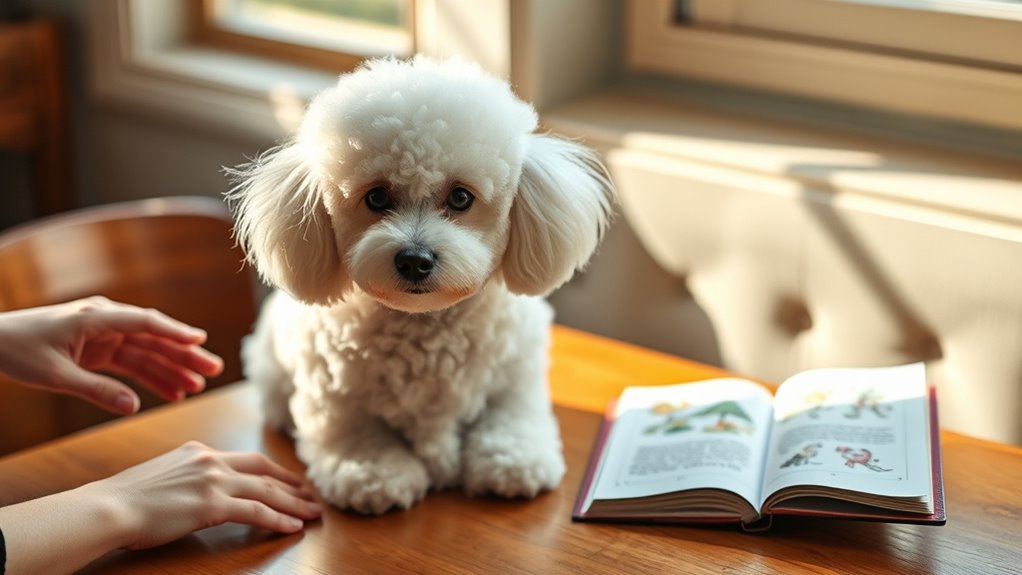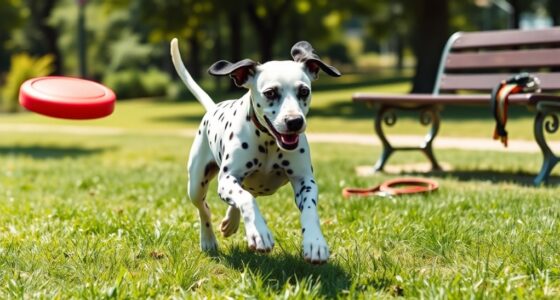Regular grooming and consistent training are key to revealing your poodle’s impressive intelligence and keeping its coat healthy. Brushing several times a week prevents matting, while introducing grooming routines guarantees your dog tolerates handling calmly. Teaching behaviors like standing still makes grooming safer and easier. Plus, caring for ears, teeth, and nails boosts overall health. If you want to discover how grooming and brainwork go hand-in-hand, keep exploring to find out more.
Key Takeaways
- Regular grooming sessions stimulate a poodle’s mental engagement through handling and positive reinforcement.
- Training grooming behaviors enhances a poodle’s obedience and cognitive skills.
- Grooming routines provide mental stimulation, helping prevent boredom and associated behavioral issues.
- Poodles’ high intelligence enables easy training for grooming tasks, reinforcing mental sharpness.
- Consistent grooming and training strengthen the bond, improving cooperation and mental well-being.

Poodles are renowned for their intelligence and striking appearance, but their grooming routines are just as important for keeping them healthy and happy. One essential aspect of caring for your poodle involves proper coat maintenance. Their curly, dense fur requires regular attention to prevent matting and skin issues. Establishing a consistent grooming schedule not only keeps their coat in top condition but also provides an opportunity for you to check for abnormalities, parasites, or irritation. Regular brushing, at least several times a week, helps remove loose hair, dirt, and prevents tangles from forming. Using the right tools, like slicker brushes and combs designed for curly coats, makes this task more effective and comfortable for your dog. Besides maintaining their coat, grooming sessions are a great chance for you to bond with your poodle, ensuring they associate grooming with positive experiences rather than stress. Proper grooming also supports the overall health of the dog and can prolong their lifespan.
Equally important is integrating dog training into your routine. Poodles are highly intelligent and respond well to consistent, positive reinforcement methods. Training your poodle to tolerate grooming and handling can make maintenance easier and less stressful for both of you. Start slowly, introducing grooming tools gradually and rewarding your dog with treats or praise. Over time, your poodle will become accustomed to being touched and groomed, making future grooming sessions smoother. Training should also extend to behaviors like standing still for trimming or nail clipping, ensuring safety and efficiency. The combination of good dog training and regular grooming helps your poodle stay calm and cooperative, minimizing anxiety and resistance during grooming appointments. Consistent training also reinforces their mental stimulation, which is vital for their well-being.
You should also pay attention to their ears, teeth, and nails during grooming. Regular ear checks prevent infections, especially since poodles are prone to ear issues due to hair growth inside the ear canal. Keeping their teeth clean with brushing or dental treats promotes oral health, and trimming nails prevents discomfort and potential injury. All these tasks become easier once your poodle understands and tolerates the process, which is where effective dog training plays a essential role. Additionally, understanding the financial impact of grooming and healthcare can help you plan and allocate resources for your pet’s well-being.
Frequently Asked Questions
How Often Should I Change My Poodle’s Grooming Routine?
You should change your poodle’s grooming schedule based on their behavior and coat needs. If your poodle starts scratching or showing signs of matting, increase grooming frequency. Typically, a schedule of every 4-6 weeks works well, but adjust if your dog’s activity level or coat condition changes. Regular grooming helps prevent skin issues and keeps your poodle comfortable, ensuring their behavior remains happy and healthy.
Can Grooming Impact My Poodle’s Cognitive Development?
Imagine your poodle’s senses awakening as you gently brush and handle their fur, stimulating their dog sensory perceptions. Regular grooming routines not only keep them clean but also engage their mind, encouraging curiosity and confidence. This sensory interaction can positively impact their cognitive development by providing mental stimulation, helping your dog become more alert and responsive. So, yes, consistent grooming can support your poodle’s mental growth and overall well-being.
Are There Grooming Techniques That Stimulate Brain Activity?
Yes, certain grooming techniques can stimulate your poodle’s brain activity through sensory stimulation and tactile engagement. Try introducing varied textures, like soft brushes or textured gloves, during grooming sessions. Incorporate gentle massages and different brushing patterns to engage their senses actively. These activities not only keep your poodle mentally stimulated but also strengthen your bond, making grooming a fun, enriching experience that promotes their cognitive development.
What Grooming Tools Are Best for Mental Stimulation?
Did you know that engaging your dog’s mind can boost their happiness and health? The best grooming tools for mental stimulation include textured brushes and interactive combs that challenge your dog’s senses. Using these tools during grooming sessions stimulates mental activity as your dog focuses on the sensations, making grooming more than just a clean-up. Incorporate different tools to keep their mind active and strengthen your bond.
How Does Grooming Frequency Affect Poodle Intelligence?
Increasing grooming frequency benefits your poodle’s intelligence by providing behavioral enrichment and sensory stimulation. Regular grooming sessions keep your dog engaged, helping them learn routines and commands, which boost their mental sharpness. The tactile sensation of brushing, combined with positive reinforcement, strengthens your bond and encourages curiosity. By making grooming a frequent activity, you enhance their cognitive development while also maintaining a well-groomed, happy, and mentally stimulated companion.
Conclusion
Now that you know how grooming keeps your poodle looking fabulous and boosts their brainpower, you realize you’re not just caring for a dog—you’re nurturing a genius with a stylish coat. Regular grooming isn’t just about looks; it’s like giving your pup a mental workout that’s more powerful than a rocket launch. So, keep those brushes handy and watch your clever, beautiful pup shine brighter than the stars!










